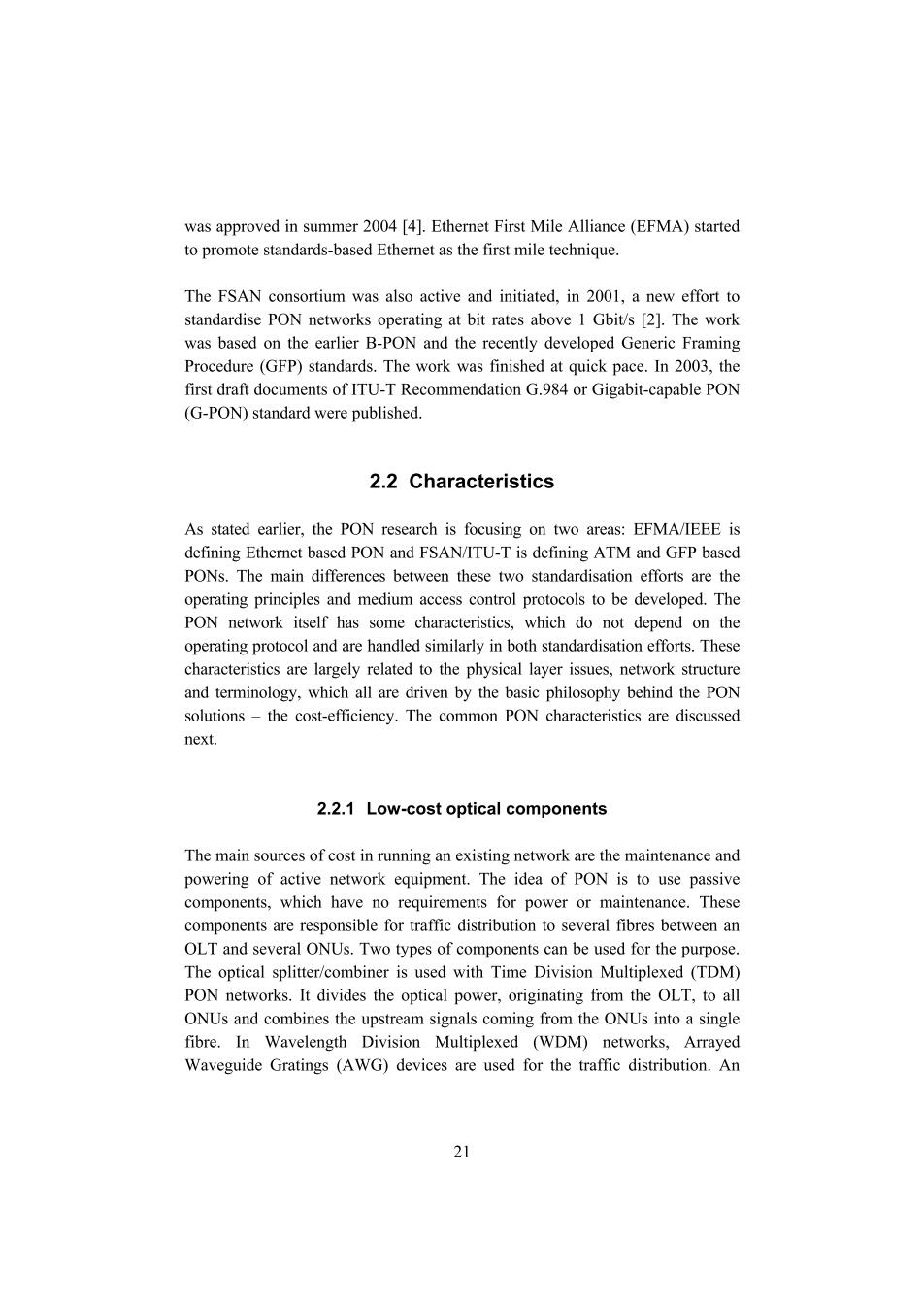正在加载图片...

was approved in summer 2004 [4].Ethernet First Mile Alliance(EFMA)started to promote standards-based Ethernet as the first mile technique. The FSAN consortium was also active and initiated,in 2001,a new effort to standardise PON networks operating at bit rates above 1 Gbit/s [2].The work was based on the earlier B-PON and the recently developed Generic Framing Procedure(GFP)standards.The work was finished at quick pace.In 2003,the first draft documents of ITU-T Recommendation G.984 or Gigabit-capable PON (G-PON)standard were published. 2.2 Characteristics As stated earlier,the PON research is focusing on two areas:EFMA/IEEE is defining Ethernet based PON and FSAN/ITU-T is defining ATM and GFP based PONs.The main differences between these two standardisation efforts are the operating principles and medium access control protocols to be developed.The PON network itself has some characteristics,which do not depend on the operating protocol and are handled similarly in both standardisation efforts.These characteristics are largely related to the physical layer issues,network structure and terminology,which all are driven by the basic philosophy behind the PON solutions-the cost-efficiency.The common PON characteristics are discussed next. 2.2.1 Low-cost optical components The main sources of cost in running an existing network are the maintenance and powering of active network equipment.The idea of PON is to use passive components,which have no requirements for power or maintenance.These components are responsible for traffic distribution to several fibres between an OLT and several ONUs.Two types of components can be used for the purpose. The optical splitter/combiner is used with Time Division Multiplexed (TDM) PON networks.It divides the optical power,originating from the OLT,to all ONUs and combines the upstream signals coming from the ONUs into a single fibre.In Wavelength Division Multiplexed (WDM)networks,Arrayed Waveguide Gratings (AWG)devices are used for the traffic distribution.An 21
!
"
#
$
%
&
' '
""
()&
*
+!
!
,! -$
* !
. ()&
/
,
+ (
,(
$
*"
#
*
01'
"
"
"0$2 $3
,45 , +!
!
()&
, ()&
!
67689:;:<=>;?@=?<@
'
()&
"
+
A
-0
" +
!
()&
%
&-0$2 $
" +
$
,(!
()&$
""
!
""
+
!
$
()&
*
"
'
+
/ !
"" $
+
/
/
/
'
*
+/'
!/
!
/!
()& B
""
/$
()&
C 6767DEFGH<F@=FI=?<:J<FKIFL>L=@ $
"
+
C +
*
+ "
*
#
$
"()&
'
#
"
$
!
" ""
!
" !
!
)M$
)&2$ /
"
!
"
$
-
!
$
N
C
$N ()&
*0
' + +"
)M$' )&2
!
+
+"
)&2 +
" !
0O
+N
C
ON
*'
/
O
+
, +
O,
"
""
!
�������������������������������������������������������������������������������������������������������������������������������������������������������������������������������������������������������������������������������������������������������������������������������������������������������������������������������